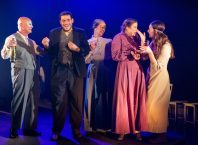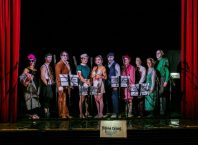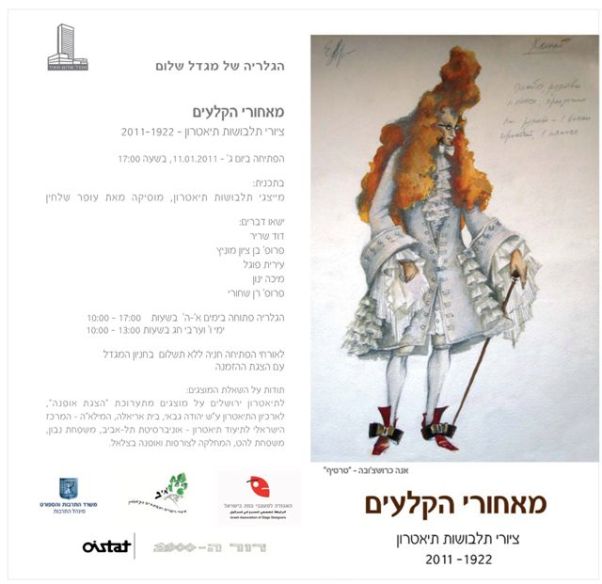
BEHIND THE SCENES, an exhibition of costume designs for the Hebrew theater is a gem of an exhibition. On display are scores of enchanting paintings and sketches by some 30 artists working on theatrical productions from the 1920s to the present day. But its presentation is problematic. It lacks a wall text or catalog summarizing the development of the Hebrew theater. Consequently, only visitors having some knowledge of the history of the subject will be able to place the exhibits in their historical context. The rest will undoubtedly derive pleasure from these beautiful works, but only on a superficial level.
Further limiting the exhibition’s appeal is the fact that the captions giving the designer’s name and the relevant production are only in Hebrew. This is a skewed decision, (and one so easily rectified) that does not take into account that the exhibition’s is located in a business center attracting many foreign visitors.
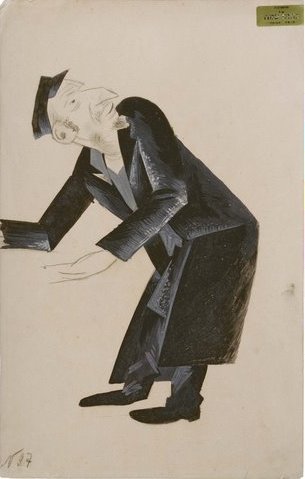
Quite rightly, Nathan Altman’s costume sketches for The Dybbuk (1922) – written by S.Ansky translated by Bialik – are prominently exhibited, since this play, directed by Y. Vachtangov, was a major triumph for the Moscow-based Habimah, the first professional Hebrew theatre in the world. It is also one of the best known productions in the history of modern theater.
Altman’s style of costume and stage designs were heavily influenced by the Cubo-Futuristic style adopted by avant garde artists in Russia after the revolution. In line with this style in which fragmented shapes are combined with dynamic movement, Altman’s designs incorporated angular and circular forms. But they also were asymmetrical, a feature that emphasized the deformities of some of beggarly characters in the play.
.
As part of The Dybbuk exhibit, it would have been rewarding to see photographs of the original costumed production. In particular, of the actress Hanna Rovina in the role of Leah-le, her black hair in braids, wearing a white silk dress. After Habimah’s relocation in 1931 to its new home in Tel Aviv, this iconic image became part of the theater’s logo.
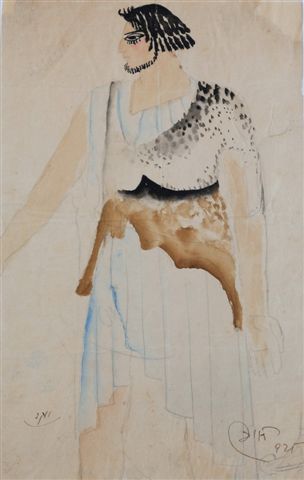
Displayed near the entrance are costume designs for productions dating from the early years of the State and mounted by a clutch of new theater groups, among the Ohel theater and the Theater of Eretz Israel. Many of these painted sketches are by well known Israeli artists, among them Menachem Shemi, Yosl Bergner and Reuven Rubin, who over the years tried their hands intermittently at costume (and stage) design, their approach invariably allied to their style of painting.
Rubin is represented by the sketches he made for Jacob’s Dream (Theater of Eretz Israel, 1925), a play staged earlier the same year by Habimah Moscow in which the stage and costume designs by Robert Falk were in a Cubo-Futurist style. Rubin, however, had a different approach, striving in his designs for realism and the authentic Eretz Israel atmosphere that characterized his paintings. In the example illustrated here, Rubin has dressed a bearded figure in a garment thought suitable for ‘biblical’ times: a shift resembling a Greek chiton, with an animal’s hide draped around the waist.
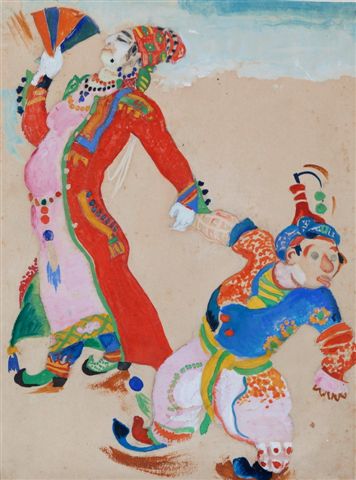
In contrast to the occasional forays of these painters into the world of stage design, Ukrainian born Arieh El-Hanani designed sets and costumes for a score of productions mounted in Tel Aviv in the 1920s and ’30s. Prior to his arrival he had studied at the Kiev School of Art and Architecture and had adopted the prevalent Constructivist style of Russian revolutionary art. This element is not, however, in evidence in his early, gently humorous designs in Eretz Israel for productions like The Book of Esther (Ohel Theater 1930). Instead their bright coloration recalls traditional Russian icon art. But more than anything else, these designs appear to be executed by an artist newly enchanted with an Orient peopled with exotic characters.
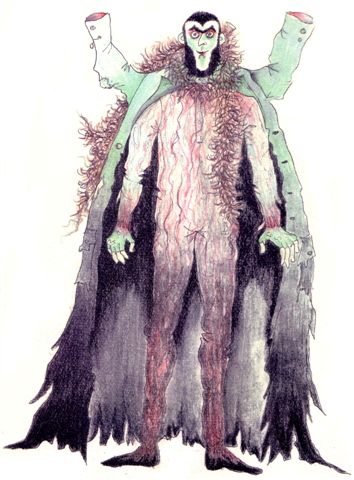
Garments worn for stage productions in the 1960s and ’70s are on view, including a trio of elegant gowns designed by Tova Kleiner Sadan for a Cameri production of Mary Stuart. Among other outstanding exhibits from those years are David Sharir’s super imaginative drawings for the ugly trolls that appeared in Habimah’s 1970 production of Peer Gynt. And then there are Anna Khrushcheva’s gorgeously foppish costumes for Moliere’s 17th century Tartuffe performed by the Gesher theater in 1995 (see above for illustration on the invitation to this exhibition).
From the 1980s, come examples of Ruth Dar’s inspired collaborations with the late playwright-director Hanoch Levin. Her designs for stage and costumes greatly enhanced the atmosphere of his plays, whether satires, domestic comedies or doom-filled tales, among them Everbody Wants to Live (Cameri 1985). Theater critic Dorit Yerushalmi commenting on this play, describess the garments worn by some of the actors as giving them the appearance of strange birds: “Empty sleeves attached to the garments of these angels of death flapped around continually as a substitute for the more familiar angels’ wings.” These ‘avian’ costumes are just one example of Dar’s extraordinary ability to enhance the spirit of a production through imaginative costuming, a talent richly shared by so many of the designers participating in this exhibition.
A tip to any potential layperson- visitor: it would be worth reading a brief history of the Israeli theater before visiting this show. Here are two excellent sources: Orna Ben-Meir, Biblical Thematics in Stage Design for the Hebrew theater , and Shimon Levy, The Development of Israeli Theater – A Brief Overview .
In conjunction with this show, curated by Tali Itzhaki, a study day and workshops were held last week, organized by AMBI the Israeli association of theater designers with the support of the Arts Administration Dept. of the Ministry of Culture. In addition to Jerome Maeckelbergh, the Belgian director of the Digital Theatre Words (DTW) project of the International Organization of Scenographers, two celebrated designers participated: Prof. Pamela Howard and Donatella Barbieri, whose visits were sponsored by BI ARTS a British Israeli program for the Arts.
Shalom Towers, on Ehad Ha’am Street (where it meets Herzl), exhibition gallery, 1st Floor; Tel: 03.5179965
Exhibition open until June 2011
ANGELA LEVINE



